GOTO BASIC
“Initiation into programming” (1997, at 286th), the second money earned at school for writing computer science programs for losers (the first money was for solving problems in physics), winning place at the regional programming competition (although they accepted only in Pascal and Syah, I got the BASIC compiler and armed with a speech about discrimination, I downloaded exe-shniki made on BASIC (Rolled). The first programs for encryption, the rotation of the picture by 90 degrees ... It was all on BASIC (and friends even wrote music and 3D Tetris).
Recently on Habré flashed the translation "50 years of BASIC!" And I decided to investigate the history of the creation of BASICs.
Of the 318 versions of BASIC, I will touch no more than 10.
 In 1964, two professors at Dartmouth College created BASIC as a tool through which non-programmers could independently create computer programs to solve their own problems.
In 1964, two professors at Dartmouth College created BASIC as a tool through which non-programmers could independently create computer programs to solve their own problems.
')
John Kemeny , studied with Richard Feyman and Alonzo Church (the developer of λ-calculus ), led an acquaintance with von Neumann and advised Einstein on mathematical questions.
Thomas Kurtz , studied with John Tukey (author of the words "software" and "bit").
Both were awarded medals "Pioneer computer technology."
BASIC was originally implemented on the GE-265 mainframe with support for multiple terminals.
Contrary to popular belief, at the time of its appearance it was a compiled language .
When designing the language used the following eight principles. The new language was supposed to:
- be easy to use for beginners;
- be a general purpose programming language;
- provide the possibility of expanding the functionality available to experienced programmers;
- be interactive;
- provide clear error messages;
- quickly work on small programs;
- do not require an understanding of the hardware;
- protect the user from the operating system .

John Kemeny teaches students BASIC.
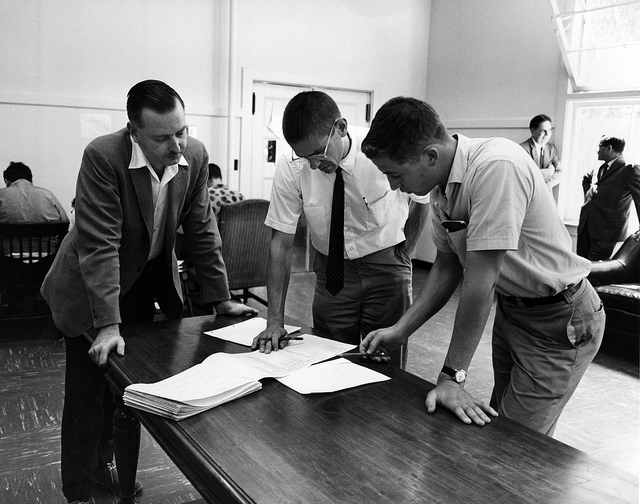
Kurtz and Kemeny help students deal with printouts of the program in BASIC.

A Matic program on BASIC, launched remotely on the mainframe. Teletypes then worked with yellow paper. Imagine that this is not a gif, but a sheet of paper crawling out of a teletypeprinter .
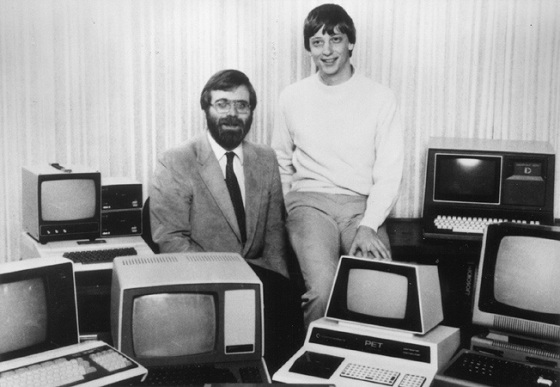
Yes that's him
Altair 8K BASIC on paper tape
 In 1975, Microsoft (then it was only two - Bill Gates and Paul Allen, with the participation of Monte Davidov), released Altair BASIC. Then its versions appeared on another platform under a license and soon there were already millions of copies and variants in use; one of the options, Applesoft BASIC, has become the standard language for the Apple II. For the CP / M operating system, the BASIC-80 dialect was created, which for a long time determined the development of the language.
In 1975, Microsoft (then it was only two - Bill Gates and Paul Allen, with the participation of Monte Davidov), released Altair BASIC. Then its versions appeared on another platform under a license and soon there were already millions of copies and variants in use; one of the options, Applesoft BASIC, has become the standard language for the Apple II. For the CP / M operating system, the BASIC-80 dialect was created, which for a long time determined the development of the language.
Altair BASIC was a new milestone in the history of programs - the first programming language for the first personal computer and the first software product from Microsoft.
BASIC was Microsoft’s main source of revenue until the early 1980s, when it switched to MS-DOS.
Read more about Altair BASIC on Wikipedia
and here is Altair itself


The Applesoft BASIC interpreter was written by Microsoft to replace the Integer BASIC system, which was used in the very first Apple II model and had very limited capabilities. The Applesoft BASIC interpreter has been flashed into the ROM of all Apple II models, starting with Apple II +, and all Apple II clones. Also, an earlier and more limited version of Applesoft BASIC was available on cassettes for the very first Apple II model.
Along with the Applesoft BASIC interpreter, Microsoft subsequently developed a fully compatible Microsoft Applesoft Compiler, which enabled it to speed up the execution of programs. The compiler itself was written in Applesoft BASIC and compiled using itself.
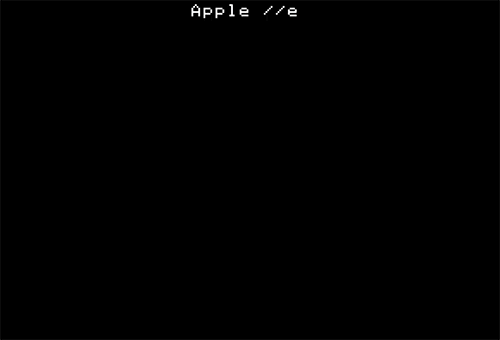
A game written by Steve Wozniak on Integer BASIC, written by Steve Wozniak
To prevent the user from becoming confused, Integer BASIC and Applesoft BASIC displayed on the display various hints for the input prompt - “>” and “]”, respectively.
Leo Christofferson: Android Nim


Sinclair BASIC (named after the inventor of Sir Clive Sinclair) is a dialect of the BASIC programming language used on 8-bit consumer computers, including and on the ZX Spectrum
Comments from Habr: “My first Vasik was Sinclair BASIC, with him I first joined programming. They wrote on the Soviet counterparts of the Spectrum "Duet" and "Nathan." We then lived in a small town and, it is frightening to think, we learned a language without Google and almost without documentation. Each new operator, each team was a Discovery, they often had to guess at random about their purpose and syntax by typing; it was considered to be a lucky person to find a knowledgeable person and learn a couple of new features from him. It was incredibly joyful to look at my first programs: drawing with a joystick, moving simple shapes, or even playing simple melodies. ”
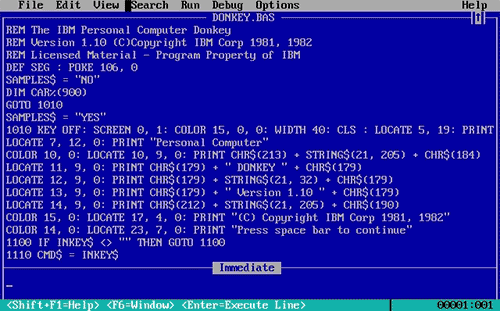
DONKEY.BAS bundled with the IBM PC in 1981. co-author of someone "Bill Gates"

Quick basic
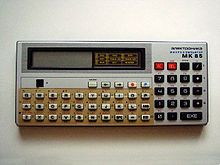
In the mid-1980s, BASIC became the main language in complex models of programmable calculators, which, by that time, had reached the level of power that allowed the use of a full-fledged high-level language. BASIC (“Vasik”) was built into the Soviet calculator “Electronics MK-85” and all its later models. The use of BASIC as the main HLL of programmable calculators continues to this day; Nowadays, it is the “calculator” BASIC that most resembles the original version of the 1960-80s
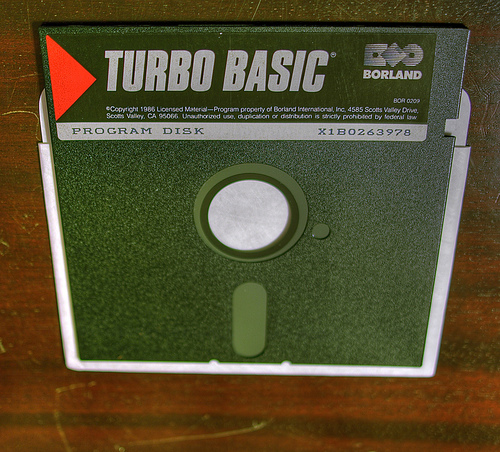
Robert "Bob" Zale in 1987, based on his many years of development BASIC / Z created Turbo Basic, and then sold it to Borland. Infoworld magazine called it one of the most significant products of the year.
Unlike most implementations of BASIC of that period, Turbo Basic was a complete compiler that generated native MS-DOS code. Other implementations were either only interpreters or strongly depended on the runtime library. In the IDE itself, it was possible to run programs in the BASIC language for traditional debugging of BASIC code (see below) or generate a separate executable file for MS-DOS, which could be run on other systems without installing Turbo Basic or libraries to run.
When Borland decided to discontinue this product, Zale bought it back, in 1990 renaming it PowerBASIC, and founded PowerBASIC Inc. to continue its support and development.

Visual Basic language inherited the spirit, style and partly the syntax of its ancestor - the BASIC language, which has quite a few dialects. At the same time, Visual Basic combines the procedures and elements of object-oriented and component-oriented programming languages. The VB development environment includes tools for visual user interface design. The first Visual Basic was the interpreter .

MobileBASIC is an interpreted programming language used for mobile phones with MIDP-2.0 support. There are 4 implementations: as a programming environment for a computer, as a regular midlet for mobile devices, as an application for devices running Android and iOS.
The language appeared in 2002 thanks to programmer David Firth (Eng. David J Firth), as an easy and convenient tool for developing software for mobile phones.
 FreeBASIC is a high-level syntax programming language closest to QuickBASIC, as well as a compiler for it (FreeBASIC Compiler). The compiler was originally developed as a free alternative to Microsoft QuickBasic, but quickly gained new features and became a powerful development tool. The first versions of the compiler were written in Visual Basic, but now it can compile itself (written in FreeBASIC).
FreeBASIC is a high-level syntax programming language closest to QuickBASIC, as well as a compiler for it (FreeBASIC Compiler). The compiler was originally developed as a free alternative to Microsoft QuickBasic, but quickly gained new features and became a powerful development tool. The first versions of the compiler were written in Visual Basic, but now it can compile itself (written in FreeBASIC).
Photo from celebration on Flickr
First BASIC Instruction Manual from 1964 (550 kb PDF)
Structured Programming with GOTO Statements (DONALD E. KNUTH)
Time article: Fifty Years of BASIC, the Programming Language That Made Computers
PS
List of 318 BASICs
F5
Recently on Habré flashed the translation "50 years of BASIC!" And I decided to investigate the history of the creation of BASICs.
Of the 318 versions of BASIC, I will touch no more than 10.
1964
 In 1964, two professors at Dartmouth College created BASIC as a tool through which non-programmers could independently create computer programs to solve their own problems.
In 1964, two professors at Dartmouth College created BASIC as a tool through which non-programmers could independently create computer programs to solve their own problems.')
John Kemeny , studied with Richard Feyman and Alonzo Church (the developer of λ-calculus ), led an acquaintance with von Neumann and advised Einstein on mathematical questions.
Thomas Kurtz , studied with John Tukey (author of the words "software" and "bit").
Both were awarded medals "Pioneer computer technology."
BASIC was originally implemented on the GE-265 mainframe with support for multiple terminals.
Contrary to popular belief, at the time of its appearance it was a compiled language .
When designing the language used the following eight principles. The new language was supposed to:
- be easy to use for beginners;
- be a general purpose programming language;
- provide the possibility of expanding the functionality available to experienced programmers;
- be interactive;
- provide clear error messages;
- quickly work on small programs;
- do not require an understanding of the hardware;
- protect the user from the operating system .

John Kemeny teaches students BASIC.

Kurtz and Kemeny help students deal with printouts of the program in BASIC.

A Matic program on BASIC, launched remotely on the mainframe. Teletypes then worked with yellow paper. Imagine that this is not a gif, but a sheet of paper crawling out of a teletype
still old pictures
Tom Kurtz helps physiology professor George Stibitsa deal with Basic language
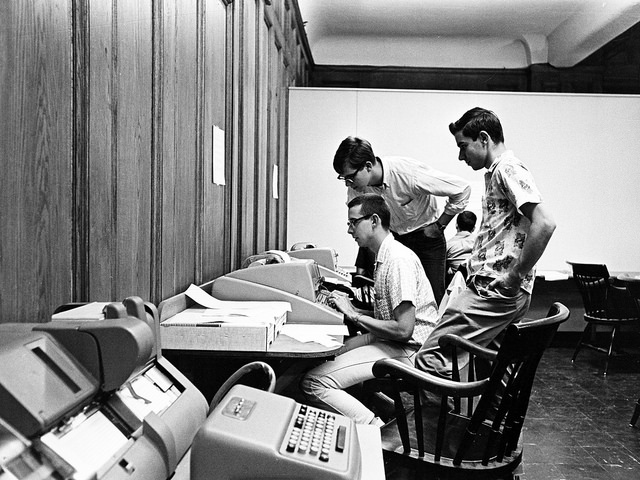
Access to the mainframe from a remote terminal

Remote access

The first "dating" with a girl from California (that's what it was all about!)
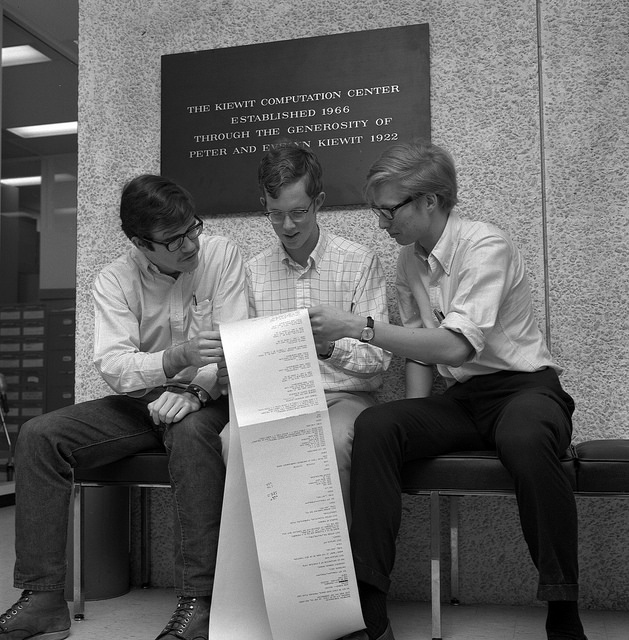
Pokak handsomes date, nerds examine program listings

A professor of geology and a professor of chemistry perform calculations for their project.
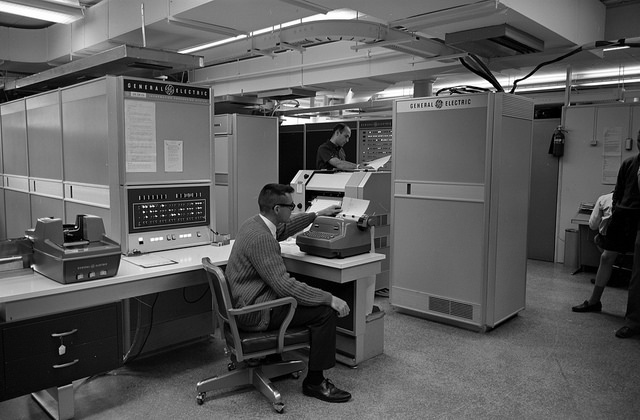
GE-225 mainframe immediately after the BASIC program execution

Professor of mathematics Kemeny. What have you achieved?

Tom Kurtz helps physiology professor George Stibitsa deal with Basic language

Access to the mainframe from a remote terminal

Remote access

The first "dating" with a girl from California (that's what it was all about!)

Pokak handsomes date, nerds examine program listings

A professor of geology and a professor of chemistry perform calculations for their project.

GE-225 mainframe immediately after the BASIC program execution

Professor of mathematics Kemeny. What have you achieved?
1975

Yes that's him
Altair 8K BASIC on paper tape
 In 1975, Microsoft (then it was only two - Bill Gates and Paul Allen, with the participation of Monte Davidov), released Altair BASIC. Then its versions appeared on another platform under a license and soon there were already millions of copies and variants in use; one of the options, Applesoft BASIC, has become the standard language for the Apple II. For the CP / M operating system, the BASIC-80 dialect was created, which for a long time determined the development of the language.
In 1975, Microsoft (then it was only two - Bill Gates and Paul Allen, with the participation of Monte Davidov), released Altair BASIC. Then its versions appeared on another platform under a license and soon there were already millions of copies and variants in use; one of the options, Applesoft BASIC, has become the standard language for the Apple II. For the CP / M operating system, the BASIC-80 dialect was created, which for a long time determined the development of the language.Altair BASIC was a new milestone in the history of programs - the first programming language for the first personal computer and the first software product from Microsoft.
BASIC was Microsoft’s main source of revenue until the early 1980s, when it switched to MS-DOS.
Read more about Altair BASIC on Wikipedia
and here is Altair itself


The Applesoft BASIC interpreter was written by Microsoft to replace the Integer BASIC system, which was used in the very first Apple II model and had very limited capabilities. The Applesoft BASIC interpreter has been flashed into the ROM of all Apple II models, starting with Apple II +, and all Apple II clones. Also, an earlier and more limited version of Applesoft BASIC was available on cassettes for the very first Apple II model.
Along with the Applesoft BASIC interpreter, Microsoft subsequently developed a fully compatible Microsoft Applesoft Compiler, which enabled it to speed up the execution of programs. The compiler itself was written in Applesoft BASIC and compiled using itself.

A game written by Steve Wozniak on Integer BASIC, written by Steve Wozniak
To prevent the user from becoming confused, Integer BASIC and Applesoft BASIC displayed on the display various hints for the input prompt - “>” and “]”, respectively.
1978
Leo Christofferson: Android Nim

1979

Sinclair BASIC (named after the inventor of Sir Clive Sinclair) is a dialect of the BASIC programming language used on 8-bit consumer computers, including and on the ZX Spectrum
Comments from Habr: “My first Vasik was Sinclair BASIC, with him I first joined programming. They wrote on the Soviet counterparts of the Spectrum "Duet" and "Nathan." We then lived in a small town and, it is frightening to think, we learned a language without Google and almost without documentation. Each new operator, each team was a Discovery, they often had to guess at random about their purpose and syntax by typing; it was considered to be a lucky person to find a knowledgeable person and learn a couple of new features from him. It was incredibly joyful to look at my first programs: drawing with a joystick, moving simple shapes, or even playing simple melodies. ”
1981

DONKEY.BAS bundled with the IBM PC in 1981. co-author of someone "Bill Gates"
1985

Quick basic
Soulful comment with Habr
I started with BASIC. From the very same Quick Basic. Then there was the pascal of the year until 1997, then - Delphi, long collected his strength to learn C - his very syntax seemed wise after Pascal’s. Moved to C / C ++ already at the institute, I mastered C # because it seemed close to me and similar to Delphi. Now I'm doing Java and Android.
And that's what I tell you. Observing the current state of the industry, in particular its attitude towards newcomers, I can’t cease to rejoice how lucky I was to be born at the dawn of the IBM PC.
My child is growing up. It is still quite small, but time flies by. And sometimes I ask myself the question - can I show her what programming is when she reaches the age of interest in such things and the main thing is that I can show her that she is interested and not scared?
I consider the question not rhetorical (in any case, I hope that the answer exists, although I have not yet found it). And where will you find now:
1. A simple language that allows you to gradually understand what are cycles and conditional transitions, operator brackets, functions and external modules
2. Reliable and elementary IDE, sharpened strictly for this language, designed to write medium-sized programs, but which is able, for example, to pull one function into the workspace and hide the rest so that a large amount of code does not frighten the immature brain
For anyone who starts telling me about simple and understandable languages for beginners, which are easily and quickly launched from the console or, God forgive me, from some emacs, I’ll clarify: the second item on this list is even more important than the first one, because a person takes the first steps hand.
In some approximation, C # and VS Express would be suitable, but, remembering how much I had to learn in order to understand Delphi (and I already knew how to code something at that moment), I understand that it will fit only as a second step, but not the first.
In QBasic, there was even a validation of the entered code when typing (!) An inconceivable feature in those times. If you do not remember, the valid operator turned into Caps (print -> PRINT), and the invalid one remained as it is, hinting at an error.
From myself I’ll say - if I hadn’t found this language and environment then, perhaps one programmer would be less. I am convinced that many will agree with me.
habrahabr.ru/post/221617/#comment_7557229

In the mid-1980s, BASIC became the main language in complex models of programmable calculators, which, by that time, had reached the level of power that allowed the use of a full-fledged high-level language. BASIC (“Vasik”) was built into the Soviet calculator “Electronics MK-85” and all its later models. The use of BASIC as the main HLL of programmable calculators continues to this day; Nowadays, it is the “calculator” BASIC that most resembles the original version of the 1960-80s
1987

Robert "Bob" Zale in 1987, based on his many years of development BASIC / Z created Turbo Basic, and then sold it to Borland. Infoworld magazine called it one of the most significant products of the year.
Unlike most implementations of BASIC of that period, Turbo Basic was a complete compiler that generated native MS-DOS code. Other implementations were either only interpreters or strongly depended on the runtime library. In the IDE itself, it was possible to run programs in the BASIC language for traditional debugging of BASIC code (see below) or generate a separate executable file for MS-DOS, which could be run on other systems without installing Turbo Basic or libraries to run.
When Borland decided to discontinue this product, Zale bought it back, in 1990 renaming it PowerBASIC, and founded PowerBASIC Inc. to continue its support and development.
1991
“Now even novice programmers can easily create applications for Windows.”

Visual Basic language inherited the spirit, style and partly the syntax of its ancestor - the BASIC language, which has quite a few dialects. At the same time, Visual Basic combines the procedures and elements of object-oriented and component-oriented programming languages. The VB development environment includes tools for visual user interface design. The first Visual Basic was the interpreter .
2003

MobileBASIC is an interpreted programming language used for mobile phones with MIDP-2.0 support. There are 4 implementations: as a programming environment for a computer, as a regular midlet for mobile devices, as an application for devices running Android and iOS.
The language appeared in 2002 thanks to programmer David Firth (Eng. David J Firth), as an easy and convenient tool for developing software for mobile phones.
2004
 FreeBASIC is a high-level syntax programming language closest to QuickBASIC, as well as a compiler for it (FreeBASIC Compiler). The compiler was originally developed as a free alternative to Microsoft QuickBasic, but quickly gained new features and became a powerful development tool. The first versions of the compiler were written in Visual Basic, but now it can compile itself (written in FreeBASIC).
FreeBASIC is a high-level syntax programming language closest to QuickBASIC, as well as a compiler for it (FreeBASIC Compiler). The compiler was originally developed as a free alternative to Microsoft QuickBasic, but quickly gained new features and became a powerful development tool. The first versions of the compiler were written in Visual Basic, but now it can compile itself (written in FreeBASIC).Photo from celebration on Flickr
First BASIC Instruction Manual from 1964 (550 kb PDF)
Structured Programming with GOTO Statements (DONALD E. KNUTH)
Time article: Fifty Years of BASIC, the Programming Language That Made Computers
PS
List of 318 BASICs
F5
Source: https://habr.com/ru/post/227711/
All Articles